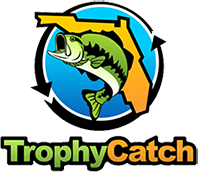
It's official — TrophyCatch Season 9 has ended, and FWC's groundbreaking citizen-science program has entered its tenth year! We would like to thank all of our participants who have made TrophyCatch a success, and each of our partners who have made the program so rewarding.
Check TrophyCatch.com for the deadline to submit any catches caught through September 30 in order to qualify for prizing, as well as to get the 10 extra chances for the upcoming Phoenix Boats bass boat drawing!
|
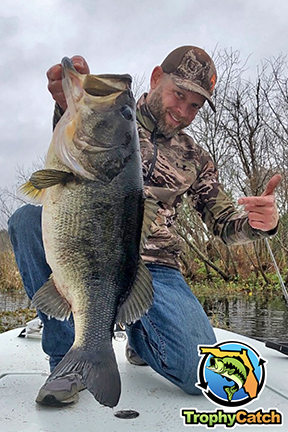 |
Even with a little time left for final submissions, we already know that we are wrapping up a record-breaking Season 9 with the highest number of Hall of Fame catches weighing 13 pounds or more since the program's inception, at 25 amazing giants. This number is even more incredible when you consider that each of these bass would beat the state record in about half the country! Check the "Fisheries Biology" section below for some interesting insights into these monster catches. Here are the latest available Season 9 stats*:
- 948 Lunker Club (8 - 9.9 lbs.) bass
- 262 Trophy Club (10 - 12.9 lbs.) bass
- 25 Hall of Fame (13+ lbs.) bass
- TOTAL 1,235 approved submission for Season 9 to date
(*Note that club totals are not the final stats for Season 9)
Facebook continues to be the best place to see your TrophyCatches and those of others, as well as keep up on the latest TrophyCatch news. Be sure to follow us at the TrophyCatch Facebook page to stay in the know, or maybe get the chance to brag about your featured catch! This past quarter's most popular post was Andres Pabon's "Second 9-pounder in 2 weeks . . . No complaints here!"
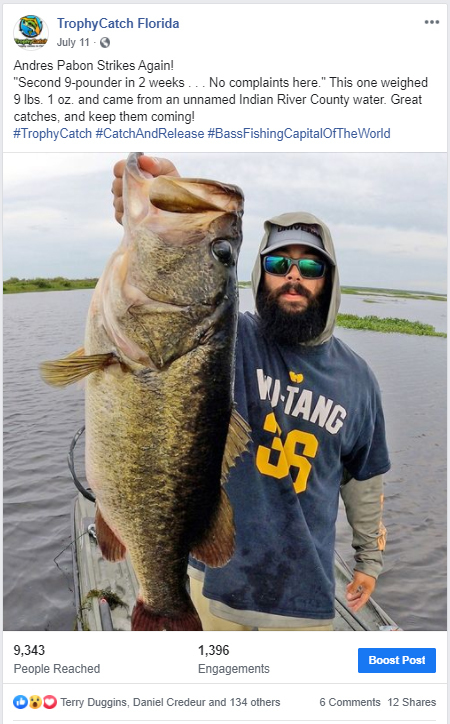 |
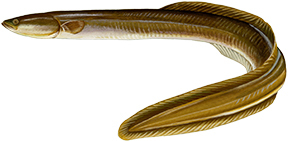
Size: The current State Record was an approximately 60-inch long male weighing about 16 pounds. Eels more commonly reach about two feet in length.
Identification and similar species: The American eel is also known as the pencil eel, yellow eel, black eel, silver eel, Boston eel, Atlantic eel or common eel. The body is extremely elongated (snakelike), with a very long dorsal fin that is confluent with the anal fin. Pelvic fins are absent and tiny scales are embedded in the skin giving eels a smooth feel. The adult color is a yellow-brown with pale underbelly. It is a distinct species with no known subspecies. The similar swamp eel (a nonnative) lacks pectoral fins.
Angling qualities: Eels are not generally considered to be a sport fish in this country. They can be caught on hook and line (live worms provide a good bait) and are taken commercially.
Behavior: Spawning is still not well understood but fascinating. The adults migrate to the ocean during autumn. The fish head to a location near the Sargasso Sea where they spawn en masse and apparently die. The eggs hatch into leaf-shaped floating larvae that drift with the currents. When they come within range of a freshwater river, the larvae metamorphoses into a tiny semi-transparent "glass eel". The glass eel then changes again into a pigmented pencil eel and continues its migration upstream to find a habitat to mature and await it's time to go spawn. American eels are considered carnivorous and eat a variety of food, including fish, frogs, and insects.
Edibility: This is a gourmet fish in the Asian markets and is often used in Sushi. It tends to be bony by American standards but is good smoked.
Where to find them: American eels are found throughout Florida. Eels are primarily riverine but access ponds, lakes, and canals. They orient to structure and flow.
Fish graphic by Duane Raver, Jr.
|
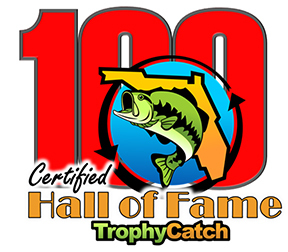 |
Not only has Season 9 beaten all previous TrophyCatch Hall of Fame (HOF) records, but the program reached a total of over 100 approved HOF submissions 13 pounds or larger this season as well! To celebrate this incredible achievement, our FWC biologists examined the HOF submission details and we asked the HOF anglers to participate in a survey to gather unique information about pursuing and catching Florida’s largest bass. Some extremely interesting — and surprising — results are provided below.
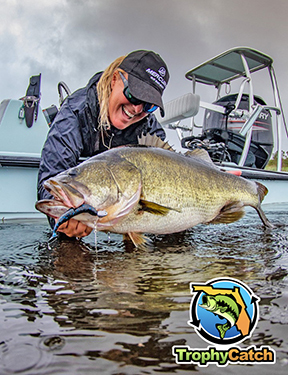 |
When were they caught? There was a distinct seasonal trend to HOF catches. Catches in February and March well exceeded catches during the rest of the year. In fact, these two months accounted for 60% of all HOF catches. It’s also interesting how much more seasonal the HOF catches are compared to overall tallies of TrophyCatch bass (which also includes Lunker and Trophy club catches). It almost goes without saying, but this springtime boom corresponds to peak bass spawning season in Florida. At that time, female bass will likely reach their greatest weight for the year, more of them will be in shallow habitats and likely more vulnerable to being caught, and knowing all this, anglers are on the water in greatest numbers.
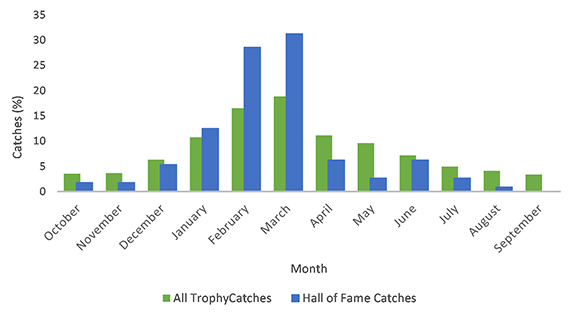 |
What time were they caught? How many of you set an alarm to wake up in the middle of the night to ensure that you are on the water and fishing at first light? How many stay on the water until the last hint of sunlight fades into night? No doubt these are great times to be on the water. However, when it comes to HOF bass, anglers caught the most during afternoon. Likely these times are reflective of when the most anglers are on the water. Also keep in mind that most of these HOF bass were also caught during the cooler months of the year when afternoons are not too hot.
 |
Where were they caught? Anglers have submitted HOFs from all over Florida. Roughly one-third of Florida’s counties can claim at least one HOF bass, ranging as far as Lee County in the south to Holmes County in the western Panhandle. Even though the footprint of HOF bass in Florida is expansive, there are certainly some hot spots. Clay and Putnam counties top the list, accounting for 30% of all HOF catches. Starting there and moving south through the center of the Florida peninsula appears to be a trophy bass corridor as the contiguous counties of Alachua, Marion, Lake, Polk, and Highlands account for another 35% of HOF bass.
These are only some of the interesting results from this very unique survey. For more fascinating information about Florida's largest Hall of Fame bass, see the TrophyCatch Hall of Fame 100 web page.
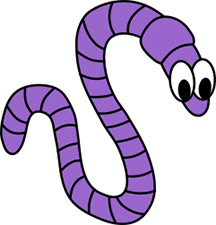
The more things change, the more they stay the same! One result from the TrophyCatch Hall of Fame 100 survey not shown above is that the plastic worm caught more HOF bass than any other lure! Despite newer lures and the fact that bass have been seeing plastic worms for over 150 years, the plastic worm is still a top bass producer. And for good reason. First, worms are easily rigged weedless, letting you reach bass a crankbait can’t touch. They’re also fairly economical, so when you do sacrifice a worm to a brushpile it doesn’t break the bank. Finally, plastic worms are so soft that bass will often hang on to them long enough for even beginners to get a solid hookset.
Styles: There are too many worm variations to cover all of them here. However, most modern offerings will fall under either the “curly tail” or “no tail” category. The curly tail on a worm can vary from a simple crescent-moon curl to longer ribbon-tailed offerings. But you don’t need a tail to catch bass. “Do-nothing” or finesse worms put plenty of fish in the boat, too. These straight or “stick” worms can be rigged and fished in the same ways as more traditional worms and may be just the ticket when finicky bass become wary of more typical offerings. These worms are usually tapered like traditional worms, but without the tail.
|
 |
A Texas rig (top) and Carolina rig (bottom). The Texas rig is the simplest and most popular.
Rigging: The two best-known worm rigs are the Texas rig and the Carolina rig. Both work well, but the Texas rig is more popular. This involves a direct line connection to the worm hook, with a sliding worm or cone sinker in front of the worm. This is a great rig for most situations and will allow you to snake a worm in and out of vegetation, stickups, or other structure without hanging up. Use the minimum amount of weight to get the job done. In fact, when fishing floating or extremely shallow vegetation, anglers can forego the worm sinker entirely and fish the worm solo across the top of the vegetation, or just below the surface.
The Carolina rig is great for fishing a weedy or otherwise cluttered bottom. A two-to-three-foot leader is tied to the worm hook on one end and to a barrel swivel on the other. The swivel is tied to the main line, with an egg sinker ahead of it. When rigged with a floating worm, this setup will allow you to work the bottom while the worm hovers above the clutter to attract a bass’ attention. Some anglers claim superior strike detection over the Texas rig with this method.
Basic techniques: One of the best things about plastic worms for beginning bass anglers is that it’s practically impossible to fish a worm wrong. If there’s such a thing as an “average” worm retrieve, it is probably bumping the worm along the bottom or through likely-looking cover, while allowing the worm to drop or rest momentarily and throwing in occasional twitches. Varying the retrieve will draw more strikes. Plastic worms work well for flipping, too. Although worms are nearly always worked slowly compared to other lures, you should go even slower when especially hot or cold weather slow the fish down.
Colors: You don’t have room in your garage for all the worm colors out there. However, keeping it simple can still provide results. A great all-around color to start with is black. Popular second choices include red shad, watermelon, pumpkinseed, purple (grape) and motor oil. While bass definitely demonstrate color preferences, at least one of these time-tested hues will usually produce fish at any given time.

The strike: Pay attention, because a bass might hit a plastic worm at any time — while it's sinking to the desired depth, while sitting motionless on the bottom, or at any moment in between. Strikes can be hard or subtle, so keep the rod tip up and the line taut in order to best detect them. You can’t judge the size of the fish by the size of the strike; a friend who caught his biggest bass — a 12-pounder — on a worm barely felt the take. If you think you’re not detecting subtle strikes, examine your worm for tiny “prickle” marks on the main body indicating it was picked up by a bass (see illustration above). Thankfully, the typical worm strike is usually more noticeable. A sharp tap-tap-tap or your line visibly twitching or moving off to one side will tell you that you’ve got a customer. Lower the rod tip and then set the hook as soon as the slack is taken up by the fish. Don’t wait too long to set the hook, as bass will readily swallow plastic worms and may become deep-hooked.
There are many other techniques and topics related to plastic worms that could be covered here. However, this should be enough to get any angler started down the road to catching more bass with the venerable plastic worm!
|
Size: 30,000 acres
Location: Orange and Lake County
Description: Lake Apopka is the fourth largest lake in Florida at 30,000 acres and was considered one of the top bass fishing lakes in the world in the 1930s and 1940s. Numerous factors contributed to the degradation of the lake and resulted in a collapse of the fishery, negatively impacting sportfish populations and angling effort. The State of Florida has focused attention on restoring Lake Apopka through multiple agencies and legislative actions (1985 Lake Apopka Restoration Act, 1987 Surface Water Improvement and Management Act, and 1996 Lake Apopka Improvement and Management Act). The most significant action was the $190 million dollar purchase of farms that were former marsh land around the north shore. Many additional restoration projects totaling tens of millions of dollars have aimed at improving the water quality and habitat of Lake Apopka.
While restoration has been a gradual process and the lake is far from its glory days of the 1930s, sportfish populations have and are continuing to improve. Although some areas of the lake remain poor habitat for sportfish, approximately 40% of the lake shoreline now supports quality habitat resulting in high electrofishing catch rates for bass that are comparable to other Harris Chain lakes.
This bass hot spots map shows areas where there have been high catch rates of bass over 16 inches documented by FWC biologists.
To increase fishing effort at Lake Apopka in 2021, FWC partnered with the Friends of Lake Apopka (FOLA) to utilize a reward-based fishing contest called the “Lake Apopka Fish Tag Challenge.” During the Challenge anglers were rewarded for catching tagged largemouth bass, black crappie, or bluegill. The goal was to incentivize anglers to fish Lake Apopka and to promote all of the fisheries restoration work, management activities, and acquired sampling data so that anglers would continue to fish Lake Apopka years after the fishing challenge.
This tagged "Jim Thomas" bass was named after the founder of FOLA and was worth a total of $5,000 during the Lake Apopka Fish Tag Challenge.
Out of the 500 tagged sportfish, 27 were caught and reported during the contest. Of these 27 tags caught 25 (92%) were largemouth bass and the other two tags were from black crappie. During the MLF Toyota series event in March 2021, angler Christian Greico caught the prized "Jim Thomas" bass (named after the founder of FOLA and pictured above). Greico was awarded a $2,500 prize from FOLA and an additional $2,500 from Bass Pro Shops for his approval of the fish into TrophyCatch. During the contest, seven TrophyCatch submissions were approval into the program with this biggest weighing 11 lbs. 13 oz. Prior to the contest, only seven other TrophyCatch approvals had come from Lake Apopka since the start of the program in 2012.
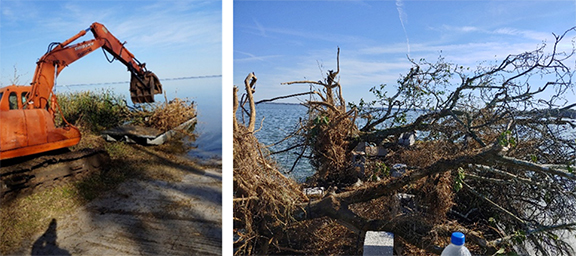 |
In January 2021 FWC partnered with the Town of Montverde, Shelley’s Environmental Systems, and the private owners of a now-defunct citrus grove to help refurbish 17 fish attractors in Lake Apopka. These sites were originally created in 2013 using natural brush, but with the passage of time the branches in those locations decayed and fell away. The newly-added orange trees (shown above) will provide ideal habitat for sportfish and great fishing opportunities for year to come.
There are 4 public boat ramps on Lake Apopka:
- Mcdonald Boat Ramp (A/B Canal: 24600 County Rd 448A, Mt Dora, FL 32757)
- Magnolia Boat Ramp (2929 S Binion Rd, Apopka, FL 32703)
- Newton Park Boat Ramp (31 W Garden Ave, Winter Garden, FL 34787)
- City of Montverde Boat Ramp (17201 Abrams Ave. Montverde, FL 34756).
Anglers can also access Lake Apopka through the lock on the A/B canal coming from Lake Beauclair.
Need a recreational hunting or fishing license? Our agency licensing website and licensing app has a new look and feel, as well as improved customer service. Visit GoOutdoorsFlorida.com or the Fish | Hunt Florida app to check it out. Remember, GoOutdoorsFlorida.com is the only official FWC licensing app out there.
To contact the Florida Freshwater Angler, email John Cimbaro.
|